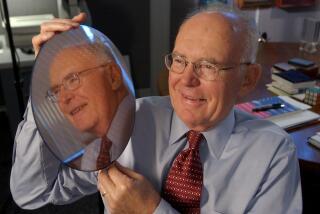IBM to Announce Space-Saving Technology for Semiconductors
- Share via
SAN FRANCISCO — IBM will announce today a series of breakthroughs in semiconductor technology that will dramatically shrink the size of computer chips and could help the industry continue to double microprocessor computing power every 18 to 24 months.
That rapid pace of improved chip performance is known as “Moore’s Law” for its author, Intel Corp. co-founder Gordon Moore--and it has held up for more than three decades. But some experts have questioned whether advances in computing power can maintain this pace after the next few years.
IBM researchers will announce a new method for saving up to 25% of the space used in today’s chips. This is accomplished by placing DRAM--a form of high-speed computer memory--underneath other chip layers, which shrinks processors without actually reducing the dimensions of the microscopic circuits they hold.
The smaller chips should be much faster, because the DRAM memory circuits would be closer to the calculation circuits that must use them, said Richard Doherty, a chip analyst with Envisioneering Group in Seaford, N.Y. In today’s chips DRAM is often on the other side of the processor, where it takes more time for the calculation circuits to access.
IBM’s developments also involve combining improved materials--including copper-based circuitry and silicon germanium substrates. This will help speed up processing, particularly for microchips that control computer networks and advanced cellular phones.
Those materials are currently used separately, but the combination exerts a kind of multiplier effect, according to Bijan Davari, vice president of IBM’s semiconductor research and development facility in Fishkill, N.Y.
“It’s like two legs of a runner. You can’t strengthen one leg and let the other one be weak,” he said.
IBM’s new methods will support higher speeds with greater reliability than today’s chips, Doherty said.
Infineon Technologies of Munich, Germany, partnered with IBM on the part of the project aimed at reducing chip size.
Details of IBM’s work will be presented Monday at the International Electron Device Meeting in Washington.
IBM’s announcement follows a series of other recent chip breakthroughs, including one by scientists at UC Berkeley that could increase chip density by a factor of 400. But the UC finding could require significant retooling in chip fabrication plants over five to 10 years.
In contrast, IBM’s methods could be implemented within two years and would not require fundamental plant changes, leading the company to predict their wide adoption throughout the chip industry.
“[IBM’s developments] are not just pie in the sky, but things they are already putting into production,” Doherty said.






